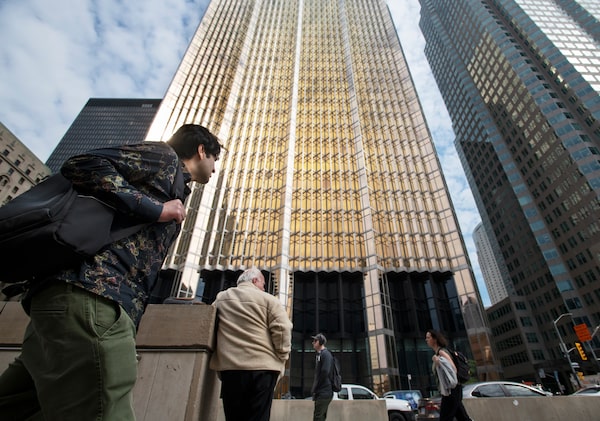
The Royal Bank Plaza on the northwest corner of Front St. West and Bay St. in Toronto’s Financial District on May 11.Fred Lum/The Globe and Mail
Gus Carlson is a U.S.-based columnist for The Globe and Mail.
For many corporate leaders, 2023 will go down as the year the dog finally started wagging the tail again when it came to getting workers back to the office.
The push was intense and widespread. Some estimates suggest 90 per cent of companies that allowed remote work during the COVID-19 pandemic imposed some sort of back-to-the-office mandate in the past year. The measures ranged from strict five-days-a-week attendance requirements to hybrid models giving workers some flexibility by allowing a rotation of in-office and at-home workdays every week.
What executive leadership considers a win, however, may be a somewhat Pyrrhic victory. A growing body of research shows an increasing number of workers who have been called back to offices, even on hybrid models, are unhappy – the unhappiest they’ve been since the start of 2020.
A recent survey of 57,000 global workers across 1,600 companies by BambooHR shows employee satisfaction dropped 10 times faster since January, 2023, than in the previous three years. Another study from the ADP Research Institute shows worker motivation in the U.S. hit its lowest level in August since June of 2022.
The research cites return-to-office mandates as a major factor in the decline of worker happiness. The technology industry in particular, where these mandates have risen, recorded the sharpest decline in happiness over the past three years – down 145 per cent – with many workers deciding to quit rather than commute, the BambooHR study said.
To be sure, companies are not in the business of ensuring workers’ happiness, no matter how employees might define it. That includes what leadership decides is in the best interest of the enterprise when it comes to who works where and how often. Wall Street firms have put sharp teeth behind their mandates, many tying compensation to in-office attendance, with non-compliance bringing financial penalties – and in some cases, the prospect of termination.
But this psychological standoff between management and the managed over what is the appropriate “next normal” cannot hold much longer without having serious consequences for business and, by extension, the economy more broadly.
As the economy continues to struggle under labour shortages, stubborn inflation, high interest rates and the spectre of a slowdown – perhaps even a recession – finding an answer for an unhappy work force is essential in helping to avoid making a bad situation worse.
It’s no longer a question of who blinks first. This is not a schoolyard shoving match. The need for compromise that serves both the needs of business and the people they rely on is at a crucial point.
A solution won’t be easy. It is somewhat ironic that the same industrial logic executives used to push return-to-office mandates is now contributing to the stalemate.
The talking points supporting the push for a return to the office are well-worn: Remote work hurts productivity, stunts collaboration and innovation, and makes creating and maintaining a healthy corporate culture difficult. Doing business via Zoom solved some of the logistical problems posed by pandemic-era restrictions, but the lack of personal interaction had a material impact on performance.
Now that workers are back, the same argument is running somewhat counter to that logic. Ask any manager and they will tell you a disengaged work force is less productive, collaborative and innovative, and its lack of motivation hurts the competitive advantage that drives growth. An unhappy work force is even worse – it can be a liability, undermining strategy, hurting customer service and serving as an anchor to initiative.
Unhappiness is also a big factor in recruiting and retaining talent. Flexibility at work, including the ability to work remotely from time to time, has become for many the single most important consideration – ahead of compensation, benefits, training and development and career advancement – when they evaluate their current job satisfaction and the suitability of other opportunities on the horizon.
While bridging the gap between in-office mandates and worker happiness is a priority, it seems the situation will get worse before it gets better. Many companies that have imposed back-to-the-office mandates, including hybrid models, plan to tighten the screws even more in 2024, requiring more in-office attendance and finding ways – motivational and punitive – to incent such behaviour.
The showdown over what the next normal will be promises to be ugly, and the consequences will go beyond hurt feelings. Considering the high stakes for businesses at a time of labour shortages and an impending slowdown, solving for an increasingly unhappy work force should be a strategic priority. The economy is counting on it.